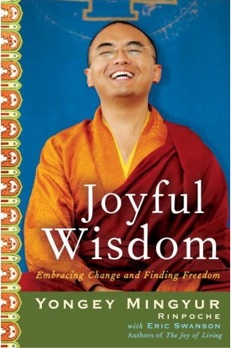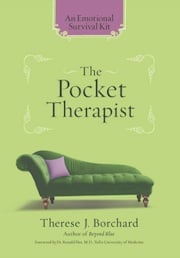
I was all set to interview Eric Swanson, coauthor (with Yongey Mingur Rinpoche) of “Joyful Wisdom: Embracing Change and Find Freedom,” when I realized that my main question–“Can you give me some concrete steps to quiet the mind?”–was already addressed in his book. So he and Harmony Books graciously gave me permission to reprint parts of chapter seven on “Attention.” Here, then, is the step-by-step approach to mindfulness or meditation–the basic practices of quieting the mind–provided in “Joyful Wisdom”:
Step One: Objectless Attention
The most basic approach to attention is referred to as “objectless”–not focusing on any specific “scene” or aspect of experience, but just looking and marveling at the wide range of scenery as it comes and goes….Objectless attention involves settling into this “is-ness,” simply watching thoughts, emotions, appearances, and so on, as they emerge against or within the background of “space.”
Step Two: Attention to Form
Form meditation simply involves raising this unconscious process to the level of active awareness. Just by looking with bare attention at a specific object, the restless bird [your mind] settles on its branch….When you rest your mind on an object you’re seeing it as something distinct or separate from yourself. But when we let go and simply rest our minds in bare attention, gradually we begin to realize whatever we see, and however we see it, is an image made up of thoughts, memories, and the limitations conditioned by our sensory organs. In other words, there’s no difference between what is seen and the mind that sees it.
Step Three: Attending to Sound
Attending to sound is very similar to attending to form, except that now you’re engaging the faculty of hearing instead of sight….Gradually allow yourself to pay attention to sounds close to your awareness, such as your heartbeat or your breath. Alternatively, you can focus on sounds that occur naturally in your immediate surroundings, such as rain pattering against a window, the noise of a television or stereo coming from a neighbor’s apartment, the roar of an airplane passing above, or even the chirps and whistles of restless birds outside.
Step Four: Attending to Physical Experience
Our embodied state is a blessing in disguise, fertile ground through which we may discover the possibilities of awareness. One way to access these possibilities is through paying attention to physical sensations, a process that may be most simply accessed through watching your breath. All you have to do is focus your attention lightly on the simple act of inhaling and exhaling. You can place your attention on the passage of air through your nostrils or on the sensation of air filling and exiting your lungs. Focusing on the breath is particularly useful when you catch yourself feeling stressed or distracted. The simple act of drawing attention to your breath produces a state of calmness and awareness that allows you to step back from whatever problems you might be facing and respond to them more calmly and objectively.
Step Five: Attending to Thoughts
Paying attention to thoughts isn’t aimed at stopping thoughts, but simply observing them. Like taking time to look at a rose or listen to a sound, taking time to observe your thoughts doesn’t involve analyzing the thoughts themselves. Rather, the emphasis rests on the act of observing, which naturally calms and steadies the mind that observes. You can use your thoughts rather be use by them. If a hundred thoughts pass through your mind in the space of a minute, you have a hundred supports for meditation….There’s no need to become attached to the awareness of a thought or to focus on it so intently that you attempt to make it go away. Thoughts come and go, as an old Buddhist saying holds, like “snowflakes falling on a hot rock.” Whatever passes through the mind, just watch it come and go, lightly and without attachment, the way you’d practice gently resting your attention on forms, sounds, or physical sensations.
Step Six: Attending to Emotions
The method of observing emotions varies according to the type of emotion you’re experiencing. If you’re feeling a positive emotion, you can focus on both the feeling AND the object of the feeling. For example, if you’re feeling love for a child, you can rest your attention on both the child AND the love you feel for him or her. If you’re feeling compassion for someone in trouble, you can focus on the person needing help AND your feeling of compassion….A more practical approach to emotions, similar to that of working with thoughts, is simply to rest your attention on the emotion itself rather than on its object. Just look at the emotion without analyzing it intellectually. Don’t try to hold on to it or resist it. Simply observe it. When you do this, the emotion won’t seem as solid, lasting, or true as it initially did.
* Click here to subscribe to Beyond Blue! And click here to follow Therese on Twitter. And click here to join Group Beyond Blue, a depression support group. Now stop clicking.

